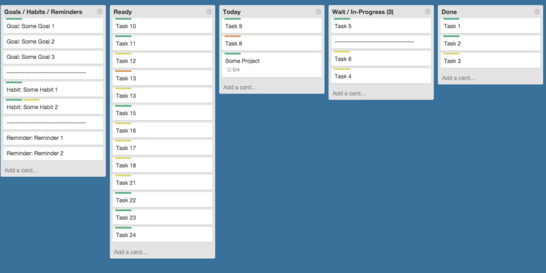Today during my team’s daily standup I ran through my list of action items for the next 24 hours. They’re pretty representative of a normal day for me:
- Write this monthly column.
- Record a new introduction video for use in all our online Agile Marketing Fundamentals courses.
- Train the executive team for a client for 3 hours.
- Submit a proposal for a new prospective grocery store client.
- Prepare materials for next week’s accreditation of new coaches.
When I finished giving my update, one of the other partners sarcastically asked, “Is that all?”
Honestly it’s not, as I also have two kids at home whose online learning needs supervision, as well as a new house full of boxes that need unpacking. There will also be a constant flurry of emails and Slack messages, some of which will require an immediate response.
But all of that will be checked off by the end of the working day (which, to be clear, is at 5pm, not 11pm).
I’m not a super productive genius or anything, but I do have tools and systems that, when applied correctly, are kind of like super powers.
As we enter into some of the busiest, craziest times of the year in a year that is already setting land-speed records for crazy, it seems like the right time to share three Agile practices that hold the key to managing the unending stream of to-dos facing modern knowledge workers.
Doing Agile Doesn’t Mean Being Agile
This article is going to be all about Agile practices — small, tactical, recurring activities — that can help knowledge workers of all kinds manage their professional lives more effectively.
But it’s crucial to remember that practices are just one small piece of the Agile puzzle.
You can incorporate these tools into your own personal work management systems, and you’re likely to see enormous improvements in productivity, but you’re going to be doing Agile, not necessarily being Agile.
To achieve the latter, you need to make changes at a more fundamental level, often called the Agile mindset. Once that takes hold, you’ll plan your work differently, collaborate early and often with team members and stakeholders, deliver value every few weeks instead of a few times a year, and maybe even completely rearrange your teams.
But for now, let’s focus on the mountain of stuff about to bury us. Once we move a little of that, we can move on to mindset change.
Agile Practice No. 1: Visualize ALL of Your Work
If you don’t have a good handle on everything — literally everything — that you could be doing, you’ll spend way too much time searching through emails, instant messages, texts, etc. to make sure you’re not forgetting something.
To ensure you focus your energy instantly and effectively in every free moment you have to work, you need a system that acts like an external brain.
In Agile, we call this a backlog.
In layman’s terms, it’s a prioritized to-do list.
But it’s also where you dump every new action item, idea and future project that hits your desk. By putting everything here, you have a unified location for all your work, and you can confidently prioritize your time knowing you’re not leaving anything out.
Make sure you create your backlog somewhere that’s easily accessible to you pretty much all the time so you can easily add items that occur to you as you’re falling asleep, folding laundry or looking at email while pretending to watch Pokemon (just me?).
-png-1.png?width=198&name=task-marketing-backlog(1)-png-1.png) My preferred tool of choice for this is Trello, because it’s easy to use and I can have it on my phone and computer easily. When I have a middle of the night idea, or get an email that contains an action item, I immediately make a new Trello card to capture it.
My preferred tool of choice for this is Trello, because it’s easy to use and I can have it on my phone and computer easily. When I have a middle of the night idea, or get an email that contains an action item, I immediately make a new Trello card to capture it.

The team I lead at AgileSherpas also has a group board that contains larger projects, and I copy the items I’m responsible for from that board to my individual board to create one single source of truth for my own workday.
Agile Practice No. 2: Prioritization, Not Planning
Once ALL the work is out there, it’s time to get ruthless and prioritize it. This means look at your huge to-do list and put just one thing at the top. This is another reason I like Trello: it lists everything in a single vertical line, so it doesn’t allow you to cheat and put two things side by side at the top of the list.
The first time you create your backlog you’ll need to prioritize everything, and it’s going to take a while. Pour a drink and devote an hour to it; you’ll be happy you did.
Because after you prioritize once, every new request or idea just needs to be put into the list where it belongs.

The beautiful thing about a prioritized backlog is that you always know the most important thing to work on. You can even tag cards that you know will be quick to process with a customized label so when a meeting ends early you can jump on them.
Typically prioritization works far better than formal planning, especially at an individual level, because things are going to crop up during your day or week that derail your plans. If you have a consistently prioritized backlog you don’t have to worry about constantly readjusting your plan when these interruptions happen.
With that said, I do look at my backlog every Monday and pull the items I think I can get done in the coming week. I keep an eye on my calendar so I’m realistic in what I pull into the weekly list, and keep the prioritization in place so I’m still doing high priority work first.
Then, each day I sit down with coffee and once again look at my calendar and weekly backlog. Given the number of meetings or trainings I have, I pull a few cards into a Today column for processing that workday. I document those in a bullet journal as well as on my Trello board, but that’s a personal preference because I like pretty pens and writing things down.
The important thing is to proceed with confidence and not spend your precious work time figuring out what you should be doing.
Agile Practice No. 3: Do One Thing at a Time
Once I have my Today column complete, it’s time to start doing stuff. Because I know thatcontext switching destroys productivity, I won’t allow myself to actively work on any more than two things at a time. Most of the time I keep that to one.
That doesn’t mean I only do one thing all day, but it does mean I won’t start a new thing until I finish the one I’m working on.
Sometimes I need a break (confession: I didn’t write this column in one sitting), and that’s where the two-items-at-a-time allowance helps. But whenever possible we should process one thing to completion.
Here’s your new mantra: stop starting, start finishing.
Knowledge Workers Need to Do Less
Yes, this is hard. Working remotely at home makes it harder. But if it was easy everyone would do it and it wouldn’t make you look like Wonder Woman when you pull it off.
Turn your email notifications off. Lock your office door. Mark yourself unavailable on Slack.
Go get stuff done. Your boss/business/colleagues/family will thank you.



